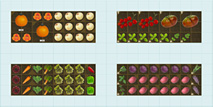How to grow Peppers?
- Latin Family: Solanaceae
- Latin Genus: Capsicum
- Ease of Growing: Moderate
- Growing Type: Annual
There are two quite distinct kinds of Peppers with very different uses; the Hot Peppers and the Sweet Peppers. Though their flavor and uses differ considerably, they are both grown in the same way. They are interesting crops to grow and fairly easy if they have warm weather.
Videos
Peppers History
Peppers have been an important crop in Central and South America for over 5000 years. Hot Peppers are highly prized for their fiery flavor and after the colonization of the New World they quickly became an important spice all around the world. They were quickly accepted in China, India and Thailand and are now as important to those cuisines as any native spices.
Soil Preference
- PH (min/max): 5.5 - 7.0
- PH Ideal (min/max): 6.0 - 6.5
Peppers like a deep, loose, moisture retentive soil that is fairly rich in all of the plant nutrients, but especially magnesium. They don't mind acid soils but don't like salt.
How to care for Peppers?
All Peppers like a warm, sunny and sheltered spot. They originated in the tropical highlands of Central and South America and grow best with warm (70 to 80˚ F) days, cool (55 to 70˚ F) nights and high humidity.
Water
Pepper plants are somewhat drought tolerant (especially Hot Peppers), but lack of water can affect fruiting, so they should be kept moist for best production. Drip irrigation works well with Peppers.
Sweet Peppers are particularly vulnerable to water stress when fruiting, so keep the soil evenly moist. If not given enough water, the fruits can develop a slightly bitter flavor (and may get Blossom End Rot).
Don't leave water on the leaves overnight as this encourages disease.
Fertilizer
Low [nitrogen]. High [potassium]. High [phosphorus]. Peppers are fairly hungry plants and require lots of phosphorus and [potassium], but not too much [nitrogen] (which may result in big vigorous plants, but few fruits).
Seeds
Seed Viability: 2 - 4 years
Germination Percentage: 55.0
It's easy to save Pepper seed (so long as it is open pollinated and not a hybrid), just allow the fruits to ripen fully, then scrape out the seeds from the fruit before you eat it. Even the seed from green fruits may be viable, if not as good. Wear gloves when collecting seeds from hot peppers.
Though Peppers are mostly self-pollinated, they do cross-pollinate to some extent. To ensure purity you should just have one variety flowering at a time, or (if your garden is big enough) you should isolate them by 500 feet. You could also isolate them under row covers. Ideally you should have a minimum of 5 plants to ensure genetic variation.
Dry the seed thoroughly and store in a cool dry place. You must store Pepper seed carefully if it is to remain in good condition, ideally as close to freezing as possible, but not below.
Light
Sun: min. 6 hours daily
Full sun. In very hot climates they may benefit from light shade.
Conditions:Warm, Hot
Season:Short Season, Long Season
Storage
Sweet Peppers can be stored in a plastic bag in the fridge for several days.
Storage Req: Refrigerator
Storage Temp: 35-40°F
Storage Length: 2-3 days
For longer term storage, both sweet and hot Peppers can be chopped and frozen.
Storage Req: Freezer
Storage Temp: 32°F
Storage Length: 180 days
Most Hot peppers can be dried for storage.
Storage Req: Drying
Storage Temp: °F
Storage Length: 360 days
Problems
Pests
Peppers have more than their fair share of pests and diseases, as do other members of the Solanaceae.
Cutworms
If Cutworms are a problem, you can make protective collars of newspaper or aluminum foil.
Fungus diseases
These are a common problem for Pepper plants, especially when they are young. Cool damp weather can make these worse, as can getting the foliage wet (use drip irrigation if possible).
Fruit drop
If the fruits drop off after they have started to swell, it may be caused by temperatures above 85˚ F, an excess of nitrogen or a deficiency of boron.
Plants may need to be shaded to prevent excessive heat.
Diseases
Peppers are fairly disease-resistant, but are susceptible to anthracnose, bacterial leaf spot, and tobacco mosaic virus (TMV). Use resistant varieties and control aphids. TMV may not kill plants but will greatly reduce the yield. Keep cigarettes out of the garden and greenhouse.
Peppers Types
- Mix
- Sweet Bell
- Specialty Sweet
- Hot
Mix Peppers combine the flavors of sweet and hot peppers.
The large fruited Sweet Peppers come in red, yellow, orange, brown, and purple. Green Peppers are simply unripe fruits and are much inferior in flavor.
Specialty Sweet Peppers come in red, yellow, orange, brown, and purple. Green Peppers are simply unripe fruits and are much inferior in flavor.
Spicy and pungent, Hot Peppers add more kick to a meal than any other common vegetable. They are an essential ingredient of Mexican, Indian and Thai cuisine. Their flavor ranges from mildly spicy to blisteringly hot.
Pests
- Blister Beetle
- Deer
- Corn Earworm
- Gophers
- Groundhog
- Leafhoppers
- Leafminers
- Raccoons
- Wireworm
- Crickets and Grasshoppers
- Carrot Beetle
- Japanese Beetle
- June Beetle
- Mealybug
- Aphids
- Colorado Potato Beetle
- Cutworms
- European Corn Borer
- Flea Beetle
- Nematodes
- Stink Bug
- Tomato Hornworm
Diseases
- Stip
- Tomato Spotted Wilt Virus (TSWV)
- Gray Mold Botrytis Fruit Rot
- Anthracnose
- Southern Blight
- Bacterial Spot
- Magnesium
- Boron
- Tobacco Mosaic Virus
- Fusarium Wilt
- Blossom End Rot
- Cercospora Leaf Spot
- Damping Off
- Late Blight
- Verticillium Wilt
- Sunscald
